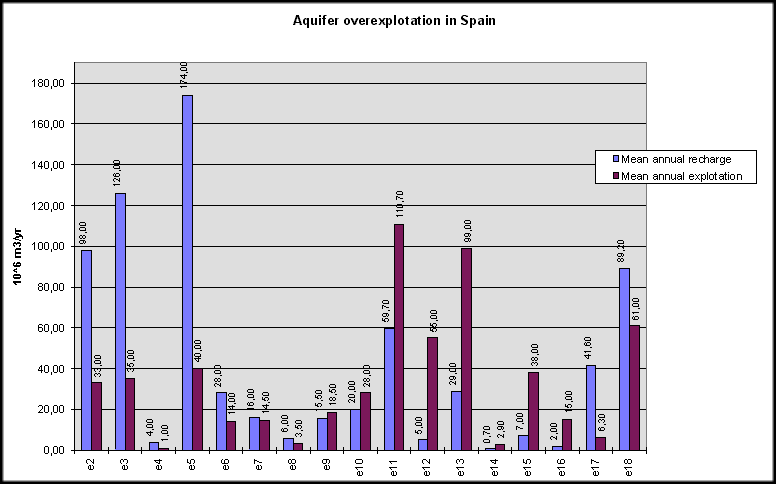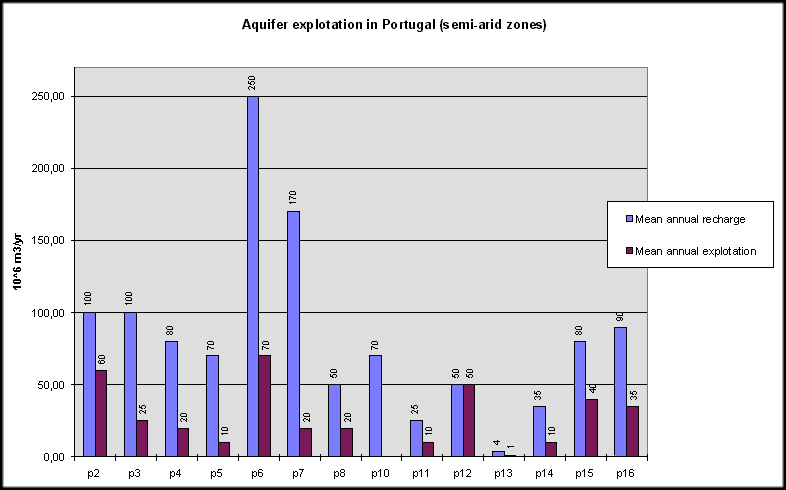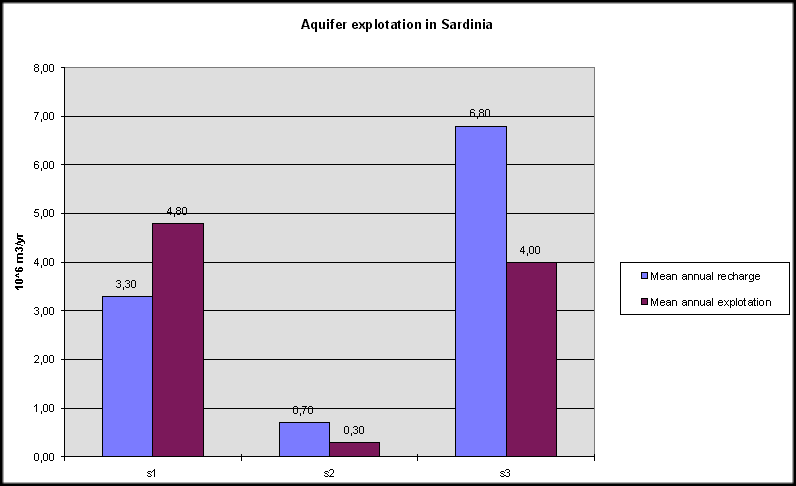3.4. Aquifer
exploitation
In semi-arid or water scarcity
regions, the aquifers play a vital role in meeting water demands, not only as regards
quality and quantity, but also in space and time.
Aquifers usually prove to be a
natural solution to water scarcity, and they are used to overcome a wide range of
situations: for supplying in some particular situations, controlling on account of their
abundant reserves and the extensive areas they cover and, for the same reason, for
transporting and distributing. They are also employed as water quality protection
elements, by providing quality reserves in zones where the surface runoff in summer proves
insufficient to maintain acceptable quality standards, and even when the runoff is too low
to maintain minimum or ecological discharges.
However the use of the potential of
aquifers in semi-arid areas brings with it the problem of average annual recharge and the
difficulties involved in its management.
Some southern EEA areas have very
little aquifer recharge. It becomes worse taking into account the great amount of tourism
in those areas, particularly in summer months, making demands to rise to very high values
compared to the rest of the year. In addition, the climate in those areas allow the
cultivation of high value crops, which also require a great deal of water for irrigation
in spring and summer.
The management problems, understood
as a set of operational rules that determine the handling of aquifers in particular and
water resource systems in general, prove particularly difficult and costly to manage and
maintain.
Intensive exploitation of aquifers
can give rise to over-exploitation problems. Aquifer over-exploitation depends on the
balance between demand and renewable resources. In the semi-arid Mediterranean regions of
Europe the absence of high rainfall and the existence of ephemeral rivers make an
increasing development of groundwater resources. This leads to over-exploitation, which
commonly arises from excessive abstraction for irrigation. The resulting increase in
productivity and change in land use can establish a cycle of unsustainable socio-economic
development within an irrigated region. Additional resources are exploited to satisfy the
increased demand from the population and agriculture, exacerbating the already fragile
environment by reducing groundwater levels and, in some circumstances, accelerating the
desertification processes (EEC, 1994). Wetlands or wet ecosystems are also damaged when
the water table drops. In contrast, over-exploitation in Northern Europe is mainly a
consequence of the fact that groundwater resources have historically provided a low-cost,
high-quality source for public water supply. Current issues are the cost of alternative
water sources, the associated infrastructure and the environmental impact of
over-exploitation.
In 1991 the EC DG XI commissioned a
report into the sustainable use of groundwater in Europe (RIVM/RIZA, 1991). It was based
on the earlier work of Fried (1983) in which a preliminary inventory of known European
cases was prepared. Over-exploitation turned out to be the major threat to the sustainable
use of groundwater in Europe. The development of guidelines for environmental impact
analysis, management tools, standardised data management and abstraction licensing were
cited as key requirements for improving management of groundwater resources.
Contamination problems also affect
numerous aquifers, either because of point-source pollution or as a result of a widespread
pollution caused by agricultural and livestock activities. Any potential decrease in water
quality depends on the activities affecting the underlying or adjacent aquifers.
3.4.1. Spain
In Spain, the systematic study of
aquifers has been carried out in the "Estudio de Delimitación de Unidades
Hidrogeológicas del Territorio Peninsular e Islas Baleares y Síntesis de Sus
Características (DGOH-ITGE, 1988)" (Definition of Hydrogeological Units on the
Spanish Mainland and the Balearics Study and Synthesis of Their Characteristics). 442
hydrogeological units have been defined up to date, covering 174,745 km2, which
amounts to approximately one third of the national territory. The total annual recharge
for these units is roughly 20,000*106 m3/year, which is equivalent
to approximately 18% of the total national runoff. This volume of groundwater resource is
slightly greater if the small aquifers of local interest are included, (MOPTMA-MINER,
1994).
Direct use of groundwater in Spain,
is currently estimated at 5,000*106 m3/year, of which 4,000*106
m3/year are destined to irrigation and the remaining 1,000*106 m3/year
are for water supply. On a national level, this means that 18 % of the total water is used
for irrigation and 22% of the total is used for water supply. Such figures could give rise
to confusion given that, for example, although Spanish irrigation activity using
groundwater only accounts for about 900,000 ha, the economic benefits obtained in these
zones are the same as or greater than those obtained in the remaining 2.300,000 ha. that
receive surface water. Furthermore, the efficiency with which groundwater is used, is
almost double than that of the use of surface water (Llamas, 1995).
A total of 51 hydrogeological units
have a pumping/recharge ratio greater than 1.0, and the deficit, obtained by calculating
the mean annual difference between pumping and recharge is 710*106 m3/year.
However, one third of this deficit corresponds to La Mancha Occidental, and an almost
identical proportion corresponds to the Province of Murcia (Valle del Guadalentin), the
rest being distributed throughout the Provinces of Alicante (River Vinalopo Basin) and
Almeria (Campo de Dalias and Campo de Nijar). To date, the Spanish government has declared
18 overexploited hydrogeological units, covering a total surface area of 13,032 km2
and having a deficit of 468*106 m3/year (MOPTMA-MINER, 1994). The
figures corresponding to each of these units are shown in Figure 3.4-1

Figure 3.4.-1
Overexploited units in Spain.
Notes (the number
region is stated in brackets -see Table 2.2-1):
e1(*): Llanura Manchega (04)
e2: Ayamonte-Huelva (04)
e3: Campo de Montiel (04)
e4: Mancha Real-Pegajalar (05)
e5: Sevilla-Carmona (05)
e6: Aljarafe (05) e15: Jumilla Villena (07)
e7: Rota-Sanlucar-Chipiona (05)
e8: El Saltador (06)
e9: Campo de Nijar (06)
e10: Andarax-Almeria (06)
e11: Campo de Dalias (06)
e12: Ascoy-Sopalmo (07)
e13: Guadalentin (07)
e14: Cresta del Gallo (07)
e16: Sierra de Crevillente (07)
e17: Bloque de Gaia (10)
e18: Camp de Tarragona (10)
(*) The mean maximum annual recharge (R) and exploitation (E) are
registered for this unit: R=340.0*106 m3/year and E=580.0*106
m3/year.
Spanish territory has been divided
into three risk zones with a view to estimating the potential impact of polluting
activities. This division has basically been carried out as a function of soil
permeability and the characteristics of the non-saturated zone. The total surface areas of
risk divided by the total surface area of the peninsula gives the following percentages:
high risk (28 %), average risk (34 %) and low risk (38 %).
In Spain, agriculture is a major
source of widespread contamination. An incorrect application of fertilisers, which are
often applied to crops in excessive amounts, coupled with inefficient irrigation
activities, causes nitrates to be washed away into the aquifers. The nitrate content of
groundwater has gradually increased in many areas where intensive farming is practised,
the concentrations of nitrate ion systematically exceeding 100 mg/l in such areas, the
value being as high as 300 mg/l in some zones. The Mediterranean coastal strip, the
Manchego plateau and the alluvial areas of the Lower Guadalquivir, are all areas where the
contamination process is most acute (MOPTMA-MINER, 1994).
3.4.2. Portugal
In Portugal, 16 aquifer systems have
been defined. The total annual recharge for these aquifers is roughly 3,200*106m3/year.
The mean annual pumping is 561*106 m3/year and only one aquifer
system has a pumping/recharge ratio which is roughly equal to 1.0. In general terms, there
are no over-exploitation problems. In the aquifer system Baixo Vouga Cretaceous,
over-exploitation occurs in one of the units in which is divided. The mean annual recharge
in it is 14*106 m3/year and the mean annual exploitation is 17*106
m3/year. In the aquifer systems Coast-Central Algarve and Coast-Oriental
Algarve over-exploitation is slight and is not considered to be a serious problem (INAG,
1995b).

Figure 3.4.-2 Aquifer
exploitation in Portugal
Notes:
All of the aquifers are used
for human purposes. There is no over-exploitation problems, except those marked as (*) or
(**).
Aquifer name:
p2 (*): Baixo
Vouga Cretaceous
p3: Mondego Cretaceous
p4: Vila Nova de Ourém Cretaceous
p5: Louriçal Tertiary
p6: Baixo Vouga Plio-Quaternary
p7: Figueira da Foz Plio-Quaternary
p8: Baixo Vouga Jurassic
p10: Estremadura Norte, Alcobaça, Torres vedras
p11(**): Algarve Central-Coast
p12(**): Algarve East-Coast
p13: Monte Gordo Dunes
p14: Occidental Algarve Jurassic
p15: North-Algarve Jurassic
p16: Algarve Upper-Jurassic.
(*)
Over-exploitation
occurs only in one unit of this system, being the mean annual recharge (R) equals to 14*10
6
m
3/year, and the mean annual exploitation (E) is 17*10
6 m
3/year.
The annual average water level decrease is 2 m. There is a risk of sea water intrusion,
yet it has not this problem at present.
(**)
There are some
overexploited points, having little importance.
The maximum mean annual
recharges are registered in aquifers p1 and p9 as follows:
p1: Tejo and Sado
Mio-Pliocene; R=1,600 *106 m3/year, E=150 *106 m3/year
p9: Orla estremenha Jurassic; R=470 *106 m3/year, E=40 *106
m3/year
3.4.3. Italy
In Sardinia, three aquifer systems
have been defined. The total annual recharge for these aquifers is 10.8*106 m3/year
and the mean annual exploitation is 9.1*106 m3/year. Muravera
(mouth) aquifer has a pumping/recharge ratio greater than 1. Muravera (mouth) and Rio Su
Cannoni-Portovesme aquifers have over-exploitation problems (Environment Department,
1995).

Figure 3.4.-3 Aquifer
exploitation in Sardinia (Italy)
Notes:
s1: Muravera (mouth).
Declared as overexploited, used for human purposes. The mean annual decrease of water
levels (W) is 2 m. The figures correspond to measures from May to August.
s2: Rio Su Canoni-Portovesme.
Declared as overexploited, not used for human purposes. W=1-2 m.
s3: Santa Lucia. Not declared
as overexploited, used for human purposes. W= 1.5-4 m.




Document Actions
Share with others